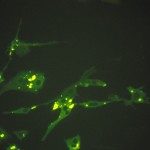Link to Pubmed [PMID] – 10859380
J. Gen. Virol. 2000 Jul;81(Pt 7):1747-55
Genetic analysis was performed of wild-type (wt) Dobrava hantavirus (DOB) strains from Slovenia, the country where the virus was first discovered and where it was found to cause haemorrhagic fever with renal syndrome (HFRS), with a fatality rate of 12%. Two hundred and sixty mice of the genus APODEMUS:, trapped in five natural foci of DOB-associated HFRS during 1990-1996, were screened for the presence of anti-hantavirus antibodies and 49 APODEMUS: flavicollis and four APODEMUS: agrarius were found to be positive. RT-PCR was used to recover partial sequences of the wt-DOB medium (M) and small (S) genome segments from nine A. flavicollis and one A. agrarius. Sequence comparison and phylogenetic analysis of the Slovenian wt-DOB strains revealed close relatedness of all A. flavicollis-derived virus sequences (nucleotide diversity up to 6% for the M segment and 5% for the S segment) and the geographical clustering of genetic variants. In contrast, the strain harboured by A. agrarius showed a high level of genetic diversity from other Slovenian DOB strains (14%) and clustered together on phylogenetic trees with other DOB strains harboured by A. agrarius from Russia, Estonia and Slovakia. These findings suggest that the DOB variants carried by the two species of APODEMUS: in Europerepresent two distinct genetic lineages.

